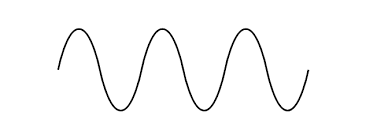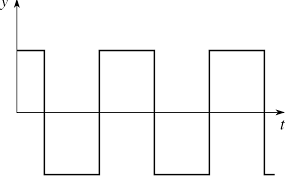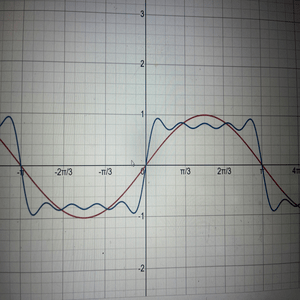Fourier Series and Transform
Claimed - Eric Carder Fall 2022
Fourier Series
A Fourier Series is an expansion of trigonometric functions to model periodic functions. This method proves useful in the study of harmonic systems as the analysis in a more familiar domain may be simpler than in its original domain. It has a variety of applications ranging from signal processing to quantum mechanics. The Fourier Series is defined as:
[math]\displaystyle{ f(x)=\sum_{n=1}^{\infty}{a_n\cos{(\frac{n\pi x}{L}})}+\sum_{n=1}^{\infty}{b_n\sin{(\frac{n\pi x}{L}})} }[/math]
for [math]\displaystyle{ x\in[-L,L] }[/math]
Intuition
Many physical systems can be modeled by square waves. Consider systems with on-off behavior, similar to an on-and-off switch. A sine wave and square wave looks like this respectively:



As the diagram hints, we can use the Fourier Series to get from the sine wave to the square wave. Consider this progression of solely sine functions. We know what [math]\displaystyle{ f(x)=\sin(x) }[/math] looks like. If we keep adding a term in the partial sum for all odd integers of [math]\displaystyle{ f(x)=\frac{\sin(nx)}{n} }[/math], the development of the square wave is noticeable as n increases:

The darker function is [math]\displaystyle{ f(x)=\sin(x) }[/math] and the lighter function is the partial sum of the series to the fifth term. As you can see, the series function is beginning to look more like a square wave as [math]\displaystyle{ n \to \infty }[/math]. In using a summation of sines (and/or cosines), we can eventually reach the square wave.
Finding Coefficients
If we take the formula for a general Fourier Series, we can manipulate it to derive the formulas for [math]\displaystyle{ a_1, a_n, }[/math] and [math]\displaystyle{ b_n }[/math]
We have [math]\displaystyle{ f(x)=\sum_{n=1}^{\infty}{a_n\cos{(\frac{n\pi x}{L}})}+\sum_{n=1}^{\infty}{b_n\sin{(\frac{n\pi x}{L}})} }[/math]
for [math]\displaystyle{ x\in[-L,L] }[/math]
Multiply both sides by [math]\displaystyle{ \cos{(\frac{m\pi x}{L})} }[/math] and integrate for [math]\displaystyle{ x\in[-L,L] }[/math]:
[math]\displaystyle{ \int_{-L}^{L}{f(x)\cos{(\frac{m\pi x}{L})}}dx=\sum_{n=1}^{\infty}{a_n\int_{-L}^{L}{\cos{(\frac{n\pi x}{L}})\cos{(\frac{m\pi x}{L}})}}dx+\sum_{n=1}^{\infty}{b_n\int_{-L}^{L}{\sin{(\frac{n\pi x}{L}})\cos{(\frac{m\pi x}{L})}}}dx }[/math]
The integral in the first series is always zero if [math]\displaystyle{ n\neq m }[/math] and the integral in the second series is always zero due to the mutual orthogonality of sines and cosines.
Hence we have the reduced equation:
[math]\displaystyle{ \int_{-L}^{L}{f(x)\cos{(\frac{m\pi x}{L})}}dx=\left\{
\begin{array}{lr}
a_m \cdot (2L), & \text{if } m=n=0\\
a_m \cdot (L), & \text{if } m=n\neq0
\end{array}
\right\} }[/math]
In noting the case that [math]\displaystyle{ m=n=0 }[/math], recall that [math]\displaystyle{ \cos(0)=1 }[/math] which yields the following when solving for [math]\displaystyle{ a_0 }[/math]:
[math]\displaystyle{ a_0=\frac{1}{2L}\int_{-L}^{L}{f(x)dx} }[/math]
And in the case where [math]\displaystyle{ m=n\neq0 }[/math], we cannot eliminate the cosine term. Solving for [math]\displaystyle{ A_m }[/math] yields:
[math]\displaystyle{ a_n=\frac{1}{L}\int_{-L}^{L}{f(x)\cos{(\frac{m\pi x}{L})dx}} }[/math]
For [math]\displaystyle{ a_n }[/math], we can repeat the process except for his time we multiply both sides of the Fourier Series equation by [math]\displaystyle{ \sin{(\frac{n\pi x}{L})} }[/math]:
[math]\displaystyle{ \int_{-L}^{L}{f(x)\sin{(\frac{m\pi x}{L})}}dx=\sum_{n=1}^{\infty}{a_n\int_{-L}^{L}{\cos{(\frac{n\pi x}{L}})\sin{(\frac{m\pi x}{L}})}}dx+\sum_{n=1}^{\infty}{b_n\int_{-L}^{L}{\sin{(\frac{n\pi x}{L}})\sin{(\frac{m\pi x}{L})}}}dx }[/math]
For the same reason as before, the first series is always equal to zero and the other series is always equal to zero if [math]\displaystyle{ m\neq m }[/math]
Hence the equality simplifies to:
[math]\displaystyle{ \int_{-L}^{L}{f(x)\sin{(\frac{m\pi x}{L})}dx}=L\cdot b_m }[/math]
Which yields: [math]\displaystyle{ b_m=\frac{1}{L}\int_{-L}^L{f(x)\sin{(\frac{m\pi x}{L})}dx} }[/math]
Example
Below is an example of finding the Fourier series of a given function:
Find the Fourier Series for [math]\displaystyle{ f(x)=x }[/math].
This is simply a matter of using the derived equations to evaluate the coefficients:
[math]\displaystyle{ a_0=\frac{1}{2L}\int_{-L}^{L}{f(x)dx} }[/math]
[math]\displaystyle{ a_0=\frac{1}{2L}\int_{-L}^{L}{(x)dx}=\frac{1}{2L}(Lx-\frac{x^2}{2})\bigg|^L_{-L} }[/math]
[math]\displaystyle{ a_0=0
}[/math]
For [math]\displaystyle{ a_n }[/math]:
[math]\displaystyle{ a_n=\frac{1}{L}\int_{-L}^{L}{f(x)\cos{(\frac{m\pi x}{L})dx}} }[/math]
[math]\displaystyle{ a_n=\frac{1}{L}\int_{-L}^{L}{(x)\cos{(\frac{m\pi x}{L})dx}} }[/math]
[math]\displaystyle{ a_n=0 }[/math] (via the opposite bounds of integration over an odd function)
For [math]\displaystyle{ b_n }[/math]:
[math]\displaystyle{ b_n=\frac{1}{L}\int_{-L}^L{f(x)\sin{(\frac{m\pi x}{L})}dx} }[/math]
[math]\displaystyle{ b_n=\frac{1}{L}\int_{-L}^L{x\sin{(\frac{m\pi x}{L})}dx} }[/math]
[math]\displaystyle{ b_n=\frac{-Lx}{\pi n}\cos(\frac{n\pi x}{L})\bigg|^L_{-L}+\int_{-L}^{L}{\frac{L}{\pi n}\cos(\frac{n\pi x}{L})dx} }[/math] (via integration by parts)
[math]\displaystyle{ b_n=\bigg(-\frac{Lx}{n\pi}\cos(\frac{n\pi x}{L})+\frac{L^2}{\pi^2n^2}\sin(\frac{n\pi x}L{})\bigg)\bigg|^L_{-L} }[/math]
Solving for the boundaries gives:
[math]\displaystyle{ \lim_{x\to-L^+}{\bigg(-\frac{Lx}{n\pi}\cos(\frac{n\pi x}{L})+\frac{L^2}{\pi^2n^2}\sin(\frac{n\pi x}L{})\bigg)}=\frac{(-1)^nL^2}{\pi n} }[/math]
[math]\displaystyle{ \lim_{x\to L^-}{\bigg(-\frac{Lx}{n\pi}\cos(\frac{n\pi x}{L})+\frac{L^2}{\pi^2n^2}\sin(\frac{n\pi x}{L})\bigg)}=-\frac{(-1)^nL^2}{\pi n} }[/math]
[math]\displaystyle{ b_n=-\frac{(-1)^nL^2}{\pi n}-\frac{(-1)^nL^2}{\pi n} }[/math]
[math]\displaystyle{ b_n=-2\frac{(-1)^nL^2}{\pi n} }[/math]
Now we have all the information we need to construct the Fourier Series:
[math]\displaystyle{ F(x)=\frac{1}{2L}\cdot0 + \sum_{n=1}^{\infty}{\frac{1}{L}(-2\frac{(-1)^nL^2}{\pi n})\sin(\frac{n\pi x}{L})} }[/math]
[math]\displaystyle{ F(x)=\sum_{n=1}^{\infty}{(-2\frac{(-1)^nL}{\pi n})\sin(\frac{n\pi x}{L})} }[/math]
Fourier Transform
The Fourier Transform is a mathematical method that converts a function of a given domain into the frequency domain. This is a particularly useful method, as it allows an analysis of systems through the frequency domain, even when we only have information for a different domain. If we consider how the Fourier Series could bring us from the trigonometric functions to the square wave, the Fourier Transform can directly convert a square wave to the frequency domain and vice versa (via inverse FT). Similar to the Fourier Series, this transformation has a variety of applications in numerous fields including electrical engineering and physics. For the time and frequency domains, the Fourier Transform is generally defined as:
[math]\displaystyle{ X(\omega)=\int_{-\infty}^{\infty}{x(t)e^{-jwt}dt} }[/math]
Or inversely:
[math]\displaystyle{ x(t)=\frac{1}{2\pi}\int_{-\infty}^{\infty}{X(\omega)e^{jwt}dw} }[/math]
Fourier Transform in Quantum Mechanics
The Fourier Transform is an essential tool in quantum mechanics, particularly when analyzing the wave function. For example, let's say for some arbitrary hypothetical reason,
we have a wave function of position, but we need to express this wave function as a function of the wave constant. We can employ the Fourier Transform to deal with this. For these variables, the Fourier Transform and inverse Fourier Transform are respectfully defined as:
[math]\displaystyle{ A(k)=\frac{1}{\sqrt{2\pi}}\int_{-\infty}^{\infty}{f(x)e^{-ikx}dx} }[/math]
[math]\displaystyle{ f(x)=\frac{1}{\sqrt{2\pi}}\int_{-\infty}^{\infty}{A(k)e^{ikx}dk} }[/math]
Quantum Example
Below is a slightly adjusted problem written by Dr. Ed Greco of Georgia Tech. The solution process will follow:
Determine the Fourier transform [math]\displaystyle{ A(k) }[/math] of the function [math]\displaystyle{ f(x)=\cos(k_0x) }[/math] for [math]\displaystyle{ x\in\bigg[\frac{-L}{2},\frac{L}{2}\bigg] }[/math] and [math]\displaystyle{ f(x)=0 }[/math] for [math]\displaystyle{ x\notin\bigg[\frac{-L}{2},\frac{L}{2}\bigg] }[/math]
Use the equation that is a function of [math]\displaystyle{ k }[/math]
[math]\displaystyle{ A(k)=\frac{1}{\sqrt{2\pi}}\int_{-\infty}^{\infty}{f(x)e^{-ikx}dx} }[/math]
[math]\displaystyle{ A(k)=\frac{1}{\sqrt{2\pi}}\int_{-\frac{L}{2}}^{\frac{L}{2}}{\cos(k_0x)e^{-ikx}dx} }[/math]
Via Euler's formula, recall that [math]\displaystyle{ \cos(q)=\frac{e^{qi}+e^{-qi}}{2} }[/math]. Using this in our problem allows us to rewrite our equation:
[math]\displaystyle{ A(k)=\frac{1}{2\sqrt{2\pi}}\int_{-\frac{L}{2}}^{\frac{L}{2}}{(e^{ik_0x}+e^{-ik_0x})e^{-ikx}dx} }[/math]
[math]\displaystyle{ A(k)=\frac{-i}{2\sqrt{2\pi}}\bigg[\frac{e^{ix(k-k_0)}}{i(k-k_0)}-\frac{e^{ix(k_0+k)}}{i(k_0+k)}\bigg]\bigg|^{\frac{L}{2}}_{\frac{-L}{2}} }[/math]
Simplifying yields:
[math]\displaystyle{ A(k)=\frac{-i}{(k_0-k)2\sqrt{2\pi}}\bigg[e^{ix(k-k_0)}-(\frac{k_0-k}{k_0+k})e^{-ix(k_0+k)}\bigg]\bigg|^{\frac{L}{2}}_{\frac{-L}{2}} }[/math]
[math]\displaystyle{ A(k)=\frac{-i}{(k_0-k)2\sqrt{2\pi}}\bigg[e^{i\frac{L}{2}(k-k_0)}-e^{-i\frac{L}{2}(k-k_0)}-\frac{k-k_0}{k+k_0}\big(e^{-i\frac{L}{2}(k_0+k)}-e^{i\frac{L}{2}(k_0+k)}\big)\bigg] }[/math]
Once again using Euler:
[math]\displaystyle{ A(k)=\frac{-i}{(k_0-k)2\sqrt{2\pi}}\bigg[2i\sin(\frac{L}{2}(k-k_0))+\big(\frac{k_0-k}{k_0+k}\big)2i\sin(\frac{L}{2}(k+k_0))\bigg] }[/math]
In taking a factor of [math]\displaystyle{ i }[/math] from the brackets, and recalling that [math]\displaystyle{ i^2=-1 }[/math], we obtain the following result:
[math]\displaystyle{ A(k)=\frac{1}{\sqrt{2\pi}}\bigg[\frac{1}{k_0-k}\sin(\frac{L}{2}(k_0-k))+\frac{1}{k_0+k}\sin(\frac{L}{2}(k_0+k))\bigg] }[/math]
History
Fourier Analysis was not initially well received. In 1807, Joseph Fourier published On the Propagation of heat in solid bodies. It was in this memoir that he laid the groundwork for such analysis. He read it to the Paris Institute and substantials in academia were not impressed. Namely. Lagrange and Laplace objected to the idea. Fourier, however, did win a prize from the Paris Institute as the result of submitting this paper to a competition. It is important to note that he was one of only two submissions in this competition.
Connectedness
Fourier Series and Transforms are applicable on a variety of frontiers. They have proven themselves useful in Modern Physics, but there is a good chance anyone in a mathematics-heavy STEM field will encounter Fourier Series and Transforms as they are heavily prevalent in other areas of science and technology. Even if these aren't useful in a given person's industry, it is still useful to understand them and their importance, as they involve a clever manipulation of information. This type of analysis is largely prevalent in signal processing: the interpretation and modification of signals.
References
Branson, J. (2013, April 22). Position Space and Momentum Space. Position space and Momentum Space. Retrieved 2022, from https://quantummechanics.ucsd.edu/ph130a/130_notes/node82.html
Cheever, E. (2022). Introduction to the Fourier transform. Linear Physical Systems - Erik Cheever. Retrieved 2022, from https://lpsa.swarthmore.edu/Fourier/Xforms/FXformIntro.html
Dawkins, P. (2022). Fourier Series. Differential equations - fourier series. Retrieved 2022, from https://tutorial.math.lamar.edu/classes/de/fourierseries.aspx
Chodos, A. (Ed.). (2010, March). This Month in physics history. This Month in Physics History. Retrieved 2022, from https://www.aps.org/publications/apsnews/201003/physicshistory.cfm
Greco, E. (2022). GPS Week 7. Modern Physics. Retrieved 2022.